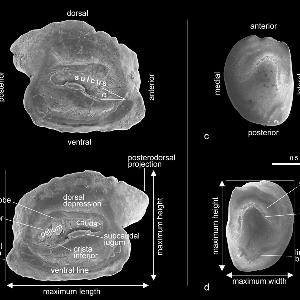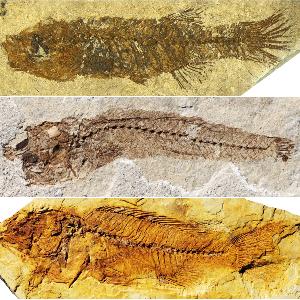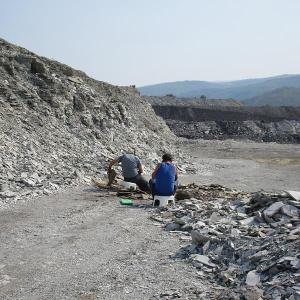Prof. Bettina Reichenbacher
Professorin für Paläontologie
Studiendekanin Geowissenschaften
Sprechstunde:
Montags: 8.30–9.30 Uhr und nach Vereinbarung

Education
Academic career
Internal
External
International activities (selection)
Ich untersuche Themen aus den zwei Forschungsgebieten Moderne Knochenfische und Miozäne Paläo-Umwelt, wobei sich oft interessante Schnittstellen wie das "Kenia-Projekt" ergeben.
Link zum Labor

© Bettina Reichenbacher
Wir interessieren uns für die Ursachen der Entstehung von Arten im Laufe der jüngeren Erdgeschichte. Unsere Schwerpunkte sind diejenigen Fischgruppen, die sich heute durch besonders hohe Artenvielfalt auszeichnen (Killifische, Grundeln, Buntbarsche). Wir versuchen zu verstehen, wann und warum es zu dieser Vielfalt im Laufe der Evolution gekommen ist, und welche Prozesse den beobachtbaren mikro- and makroevolutionäre Veränderungen zugrunde liegen. Wir arbeiten auf der Basis der vergleichenden Morphologie, und beziehen, soweit möglich, auch molekulare Daten rezenter Arten mit ein ("total evidence approach"). Wir untersuchen fossile und rezente Arten und fokussieren dabei auf deren Hartteile (Skelette, Otolithen, Bezahnung, Schuppen).
Im Kontext von Paläo-Umwelt, Paläogeographie und Paläoklima beschäftigen wir uns mit der Phylogenie und Evolution der oben genannten Gruppen:
Reichenbacher, B., Vukić, J., Šanda, R., Schliewen, U. K., Esmaeili, H. R., & Kassar, A. (2023). Skeletal traits and otoliths can unravel the relationships within European Gobiidae (Gobius lineage sensu lato). Zoological Journal of the Linnean Society, 199(3): 656-687. Link to article (free access)
Gierl, C., Dohrmann, M., Keith, P., Humphreys, M., Esmaeili, H. R., Vukić, J., Šanda, R., & Reichenbacher, B. (2022). An integrative phylogenetic approach for inferring relationships of fossil gobioids (Teleostei: Gobiiformes). PLOS ONE, 17(7), e0271121. Link to article (open access)
Herbert Mainero, A., Vasilyan, D., & Reichenbacher, B. (2024). Two new genera of killifish (Cyprinodontiformes) from the Middle Miocene of the Bugojno Basin, Bosnia and Herzegovina: insights into the lost diversity of Valenciidae. Journal of Systematic Palaeontology, 22(1). Link to article (open access)

© Bettina Reichenbacher
Im Rahmen des Projektes haben wir sehr gut erhaltene Fossilien von Cichliden (Buntbarsche) aus den miozänen Sedimenten der Tugen Hills (Baringo County) bergen können und im Hinblick auf die Evolutionsgeschichte der afrikanischen Cichliden ausgewertet.
Fieldwork was conducted in the Tugen Hills (Baringo) in August 2011, February 2013 and 2014, in a joint campaign involving the Kenyan partners of the Orrorin Community Organisation and the German research group from the Ludwig-Maximilians-Universität Munich. We collected numerous well-preserved fish fossils and several samples for analyses of pollen and clay mineralogy. In addition, several outcrops were mapped in detail.
The high preservation quality of the fish fossils from the Miocene sediments in the Tugen Hills is exceptional. Almost all fish fossils from the Ngorora Fm. belong to the Cichlidae, one of the most diverse tropical freshwater fish clades of the world. In contrast, an extinct aplocheiloid killifish dominates the fossil fish assemblage from the Lukeino Fm.
The fossil record represents a very important source of direct information for the understanding of the evolutionary history of organisms. However, with regard to the ancestors of the approximately 3000 species that make up the modern fish fauna in African freshwater habitats, the known fossil record is poor. Even from the most recent epochs, i.e. the Miocene, Pliocene and Pleistocene, only about 60 fossil taxa are known.
The Miocene sediments in the Tugen Hills (Baringo, Kenya) provide the unique opportunity to collect well-preserved fish fossils. The goals of the Kenya project are (i) to explore these fossiliferous archives, (ii) to analyse the newly collected fish fossils, together with other co-occurring fossils and sedimentological data, and (iii) to make use of the findings for palaeoenvironmental and palaeoclimate reconstructions. During two field campaigns in 2013 and 2014 we have assembled about 650 articulated fish fossils together with samples for palynological and sedimentological analyses from the middle and upper Miocene Ngorora Formation and the upper Miocene Lukeino Formation. The current aim is to identify the fish fossils from the different sites and to present them in a phlyogenetic context.
Altner, M. & Reichenbacher, B. (2015). †Kenyaichthyidae fam. nov. and †Kenyaichthys gen. nov. – First Record of a Fossil Aplocheiloid Killifish (Teleostei, Cyprinodontiformes). – PLoS ONE 10(4):e0123056. Link to article (open access).
Penk, S.B.R., Altner, M., Cerwenka A.F., Schliewen U.K., Reichenbacher, B. (2019). New fossil cichlid from the middle Miocene of East Africa revealed as oldest known member of the Oreochromini. – Scientific Reports, 9:10198. Link to article (open access)
Altner, M., Ruthensteiner, B., Reichenbacher, B. (2020). New haplochromine cichlid from the upper Miocene (9–10 MYA) of Central Kenya. – BMC Evolutionary Biology 20:65. Link to article (open access)

Bergung der Fischfossilien ind Bosnien-Herzegowina | © Davit Vasilyan, Jurassica Museum, Porrentruy, Schweiz
Die Molasseforschung hat in München eine lange Tradition. Unsere Schwerpunkte sind die Obere Meeresmolasse und die Obere Brackwassermolasse.
Wir bearbeiten Fragestellungen zur Biostratigraphie, Chronostratigraphie, Palaeogeographie, zur regionalen Geologie, zur Paläo-Umwelt und zum Paläo-Klima. Regional arbeiten wir in Europa und West Asien, mit Schwerpunkten auf das Nordalpine Vorlandbecken (Molassebecken), die ehemalige Paratethys, und Ostafrika (Kenia).
Hofmayer, F., Hadler Boggiani, B., Soman, R., Andrade, J. D., Ćorić, S., & Reichenbacher, B. (2023). An integrative palaeoenvironmental and chronostratigraphic study of the Lower Miocene in the North Alpine Foreland Basin – Are global climate signals detectable? Palaeogeography, Palaeoclimatology, Palaeoecology, 627, 111719. doi.org/10.1016/j.palaeo Link to article (free access until Sept 21, 2023)
Vernyhorova, Y. V., Holcová, K., Doláková, N., Reichenbacher, B., Scheiner, F., Ackerman, L., Rejšek, J., De Bortoli, L., Trubač, J., & Utescher, T. (2023). The Miocene Climatic Optimum at the interface of epicontinental sea and large continent: A case study from the Middle Miocene of the Eastern Paratethys. Marine Micropaleontology, 181, 102231. doi.org/10.1016/j.marmicro.2023.102231 Link to article (free access)